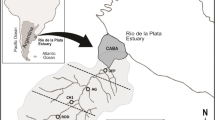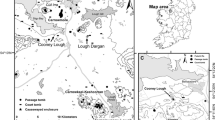Abstract
Karabash (52°2′ N, 60°10′ E) is a copper smelting town in the southern Ural Mountains of Russia. The town is affected by sulphur dioxide emissions and deposition of metal-rich particulates from the smelter, acid drainage from old mine workings, and leachates from disused waste dumps and tailings dams. The close proximity of houses to these sources of pollution is of concern to human health and has devastated terrestrial vegetation in the environs. The environmental impact of the smelter on lakes in the area has been assessed using chironomids. Short sediment cores were taken from 16 lakes within a 50 km radius of the smelter and the composition of the chironomid fauna from the bottom of each core, representing conditions prior to the commissioning of the smelter in 1910, was compared with the present chironomid fauna in the surface sediments. Redundancy analysis (RDA) showed that changes in the chironomid fauna of most lakes were driven by trophic change, independent of the industrial activity. Lakes and ponds adjacent to the smelter and waste dumps, which directly receive contaminated waters were devoid of macro- and mesofauna and flora, but there is no evidence that other lakes have been severely impacted by smelter emissions. Local geology ensures that the lakes are well-buffered to the effects of acid deposition which will limit the bioavailability of metals in the water column and sediment.
Similar content being viewed by others
References
D.E. Bouillon (1995) Developments in emission control technologies/strategies: a case study J.M. Gunn (Eds) Restoration and Recovery of an Industrial Region Springer-Verlag New York 275–285
Y.W. Brodin M. Gransberg (1993) ArticleTitleResponses of insects, especially Chironomidae (Diptera), and mites to 130 years of acidification in a Scottish lake Hydrobiologia 250 201–212
S.J. Brooks H.J.B. Birks (2004) ArticleTitleThe dynamics of Chironomidae (Insecta: Diptera) assemblages in response to environmental change during the past 700 years on Svalbard J. Paleolimnol. 31 483–498
S.J. Brooks H. Bennion H.J.B. Birks (2001) ArticleTitleTracing lake trophic history with a chironomid-total phosphorus inference model Freshwat. Biol. 46 511–532
V. Dauvalter (1994) ArticleTitleHeavy metals in lake sediments of the Kola PeninsulaRussia Sci. Tot. Environ. 158 51–61
Ferreira-Marques C. 2003. Russia’s industrial wasteland chokes on fumes. Environmental News Network, www.enn.com/news
Filipov D. 2004. Polluted town counts on Putin. The Boston Globe, www.boston.com
E.C. Grimm (1991) TILIA and TILIA GRAPH software Illinois State Museum
O. Heiri A.F. Lotter (2001) ArticleTitleEffect of low count sums on quantitative environmental reconstructions: an example using subfossil chironomids J. Paleolimnol. 26 343–350
L. Henrikson H.G. Oscarson (1985) ArticleTitleHistory of the acidified Lake Gårdsjön: the development of chironomids Ecol. Bull. 37 58–63
M.O. Hill (1973) ArticleTitleDiversity and evenness: a unifying notation and its consequences Ecology 54 427–432
W. Hofmann (1971) ArticleTitleZur Taxonomie und Palökologie subfossiler Chironomiden (Dipt.) in Seesedimenten Archiv. Hydrobiol. 6 1–50
B.P. Ilyashuk E.A. Ilyashuk (2001) ArticleTitleResponse of alpine chironomid communities (Lake ChunaKola Peninsulanorthwest Russia) to atmospheric pollution J. Paleolimnol. 25 467–475
B.P. Ilyashuk E.A. Ilyashuk V. Dauvalter (2003) ArticleTitleChironomid responses to long-term metal contamination: a paleolimnological study in two bays of Lake ImandraKola Peninsulanorthern Russia J. Paleolimnol. 30 217–230
P.H. Kansanen T. Jaakkola (1985) ArticleTitleAssessment of pollution history from recent sediments in Lake Vanajavesisouthern Finland. I. Selection of representative profiles, their dating and chemstratigraphy Ann. Zool. Fenn. 22 13–55
W. Keller J.M. Gunn (1995) Lake water quality improvements and recovering aquatic communities J.M. Gunn (Eds) Restoration and Recovery of an Industrial Region Springer-Verlag New York 67–80
P.G. Langdon K.E. Barber S.H. Lomas-Clarke (2004) ArticleTitleReconstructing climate and environmental change in northern England through chironomid and pollen analyses: evidence from Talkin Tarn, Cumbria J. Paleolimnol. 32 197–213
I. Larocque (2001) ArticleTitleHow many head capsules are enough? A statistical approach to determine sample size for paleoclimatic reconstructions Palaeogeogr. Palaeoclimat. Palaeoecol. 172 133–142
C. Lindegaard (1995) Classification of water-bodies and pollution P. Armitage P.S. Cranston L.C.V. Pinder (Eds) The Chironomidae: the Biology and Ecology of Non-biting Midges Chapman & Hall London 385–404
J.J. Meriläinen J. Hynynen A. Palomäki K. Mäntykoski A. Witick (2003) ArticleTitleEnvironmental history of an urban lake: a palaeolimnological study of Lake JyväsjärviFinland J. Paleolimnol. 30 387–406
N. Michelutti T. Laing J.P. Smol (2001) ArticleTitleDiatom assessment of past environment changes in lakes located near Noril’sk (Siberia) smelters Wat. Air Soil Pollut. 125 231–241
D.R. Oliver M.E. Roussel (1983) The Genera of Larval Midges of Canada. Diptera: Chironomidae Biosystematics Research Institute Ottawa, Ontario 263
R. Quinlan J.P. Smol (2001a) ArticleTitleChironomid-based inference models for estimating end-of-summer hypolimnetic oxygen from south-central Ontario shield lakes Freshwat. Biol. 46 1529–1551
R. Quinlan J.P. Smol (2001b) ArticleTitleSetting minimum head capsule abundance and taxa criteria in chironomid-based inference models J. Paleolimnol. 26 327–342
O.W. Purvis P.J. Chimonides G.C. Jones I.R. Mikhailova B. Spiro D. Weiss B.J. Williamson (2003) ArticleTitleLichen monitoring near Karabash Smelter Town, Ural Mountains, Russiaone of the most polluted areas in the world Biol. Lett. R. Soc. 217 221–226
I. Renberg (1991) ArticleTitleThe HON-Kajak sediment corer J. Paleolimnol. 6 167–170
M. Rieradevall S.J. Brooks (2001) ArticleTitleAn identification guide to subfossil Tanypodinae larvae (Insecta: Diptera: Chironomidae) based on cephalic setation J. Paleolimnol. 23 81–99
P.E. Schmid (1993) A key to the Larval Chironomidae and their Instars from Austrian Danube Region Streams and Rivers. Part 1. DiamesinaeProdiamesinae and Orthocladiinae Federal Institute for Water Quality Vienna 514
Ø.A. Schnell E. Willassen (1996) ArticleTitleThe chironomid (Diptera) communities in two sediment cores from Store Hovvatn, S. Norway, an acidified lake Ann. Limnol. 32 45–61
J.P. Smol (2002) Pollution of Lakes and Rivers: A Paleoenvironmental Perspective Arnold Publishers London 280
ter Braak C.J.F. and Šmilauer P. 2002. CANOCO v. 4.5. Microcomputer Power. IthacaNew York, USA499 pp.
Udachin V., Yershov V. and Lansiart M. 1998. Environmental Conditions in the Area of Exploited Massive Sulfide Deposits of the South Ural. Final Report for TACIS Contract FINRUS 9602.
V. Udachin B.J. Williamson O.W. Purvis B. Spiro W. Dubbin S.J. Brooks B. Coste R.J. Herrington I. Mikhailova (2003) ArticleTitleAssessment of environmental impacts of active smelter operations and abandoned mines in KarabashUral mountains of Russia Sustain. Dev. 11 133–142
I.R. Walker (1995) Chironomids as indicators of past environmental change P. Armitage P.S. Cranston L.C.V. Pinder (Eds) The Chironomidae: The Biology and Ecology of Non-biting Midges Chapman & Hall London 405–422
I.R. Walker (2001) Midges: Chironomidae and related diptera J.P. Smol H.J.B. Birks W.M. Last (Eds) Tracking Environmental Change Using Lake Sediments. Volume 4: Zoological Indicators Kluwer Academic Publishers Dordrecht 43–66
Wiederholm T. (ed.) 1983. Chironomidae of the Holarctic region. Keys and diagnoses. Part 1 Larvae. Ent. Scand. Suppl. 19: 1--457.
T. Wiederholm L. Erikson (1977) ArticleTitleBenthos of an acid lake Oikos 29 261–267
B.J. Williamson I. Mikhailova O.W. Purvis V. Udachin (2004) ArticleTitleSEM-EDX analysis in the source apportionment of particulate matter on Hypogymnia physodes lichen transplants around the Cu smelter and former mining town of KarabashSouth Urals, Russia Sci. Tot. Environ. 332 139–154
Author information
Authors and Affiliations
Corresponding author
Rights and permissions
About this article
Cite this article
Brooks, S.J., Udachin, V. & Williamson, B.J. Impact of copper smelting on lakes in the southern Ural Mountains, Russia, inferred from chironomids. J Paleolimnol 33, 229–241 (2005). https://doi.org/10.1007/s10933-004-3936-x
Received:
Accepted:
Issue Date:
DOI: https://doi.org/10.1007/s10933-004-3936-x




